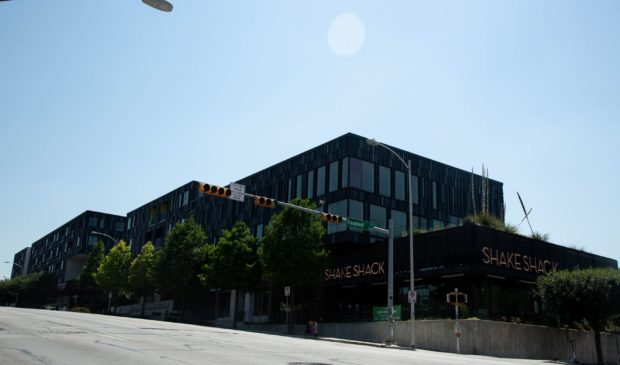How tall should buildings be when they’re near single-family homes?
Thursday, June 9, 2022 by
Audrey McGlinchy, KUT There’s a building on South Lamar that looks like a stepladder. Well, maybe a stepladder if you laid it on the ground. Or, maybe just a set of stairs – for a giant.
“As you move across Lamar, you’re literally seeing the diagram of the zoning,” said Maija Kreishman, a principal with Michael Hsu Office of Architecture, which helped design the project.
The building, which is called Lamar Union, includes nearly 500 apartments, a dozen restaurants, an Alamo Drafthouse theater, and parking garages. As you drive south, the building’s height increases incrementally, going from one story up to five.
This design is not necessarily a product of some architectural trend, Kreishman said, but instead a response to zoning rules that limit building height within a certain distance of single-family homes.
In Austin, these rules are called compatibility, and as residents struggle with the cost of housing created by a shortage of homes to buy or rent, elected officials are considering changing compatibility rules to allow developers to build more.
“We’re cutting dozens of units for the benefit of a few single-family homes,” City Council Member Natasha Harper-Madison, who represents East Austin, said at a Council meeting earlier this week.
Wait, so what is compatibility, again?
Austin adopted its current compatibility rules in the mid-1980s. Jim Duncan, who then headed what would become the city’s Housing and Planning Department, told KUT the intent was to protect those living in single-family homes.
“Shadow is the first thing,” he said. “People should not be denied, especially if you’re there first and somebody comes and builds and all of a sudden you lose your sun. … It’s privacy. It’s aesthetics. But privacy I think is even more important.”
According to an analysis by city staff, Austin has some of, if not the most restrictive compatibility requirements when compared to cities similar in size. In Seattle, for example, a developer can build up to 60 feet high once it gets at least 50 feet away from a single-family zone; in order to build this tall in Austin you’d need to move at least 300 feet away from a single-family home.
And there actually doesn’t need to be a home. A piece of land can be zoned for a single-family home and be vacant, yet still exert the same compatibility requirements.
“It’s kind of like this force field that a single-family house emits in Austin,” Jake Wegmann, an associate professor of real estate at UT Austin, told KUT.
He said if you draw a line upward from a single-family home, a would-be building nearby has to fall under it. Otherwise “that building has to be chopped down to the point where it’s below that line.”
Needless to say, some developers are not fans of compatibility.
“Other than it sucks?” Ron Thrower said, when asked if he wanted to add anything to the discussion about compatibility.
Thrower, who owns the land use consulting firm Thrower Design, said he deals with compatibility limits on about 80 percent of the projects he works on. Even if the zoning allows for a bigger building, he said, a single-family home down the block often triggers additional restrictions.
Council members propose a change
Following a meeting late last year over skyrocketing housing prices, City Council members are considering changing compatibility requirements. They say the hope is for more housing, easing the housing crisis.
“We believe there is consensus on this Council to increase housing capacity on our corridors to meet our housing goals and to support our transit investments,” Mayor Pro Tem Alison Alter wrote in an online message board used by Council.
A cohort of members – Mayor Steve Adler, Alter and Council members Leslie Pool, Vanessa Fuentes and Paige Ellis – have proposed shrinking the distance at which a single-family home can exert its power over new development.
These Council members have proposed allowing developers building on busy roads to go a bit taller. Without having to provide any affordable housing (another part of the proposal), builders would be able to go 5 feet taller than they currently can. So, at 200 feet away from a piece of land zoned for single-family, a building could stand at 55 feet instead of the current 50 feet.
Council members are also suggesting that only zoning should be allowed to trigger compatibility, meaning if a piece of land is zoned for an apartment complex but a single-family home has been built there, the presence of that house would not initiate compatibility requirements.
Restrictions would be even looser, Council members have proposed, if developers agree to make some of the apartments they’re building affordable to people earning less than the median family income.
Some Council members, including Chito Vela and Harper-Madison, have suggested compatibility requirements should be even less restrictive, but it’s not clear whether they have the votes.
This story was produced as part of the Austin Monitor’s reporting partnership with KUT.
The Austin Monitor’s work is made possible by donations from the community. Though our reporting covers donors from time to time, we are careful to keep business and editorial efforts separate while maintaining transparency. A complete list of donors is available here, and our code of ethics is explained here.
You're a community leader
And we’re honored you look to us for serious, in-depth news. You know a strong community needs local and dedicated watchdog reporting. We’re here for you and that won’t change. Now will you take the powerful next step and support our nonprofit news organization?











